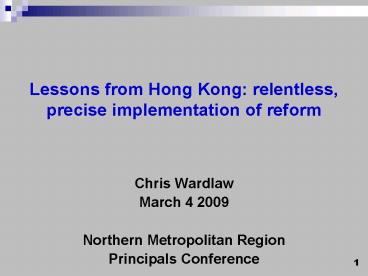Lessons from Hong Kong: relentless, precise implementation of reform - PowerPoint PPT Presentation
1 / 31
Title:
Lessons from Hong Kong: relentless, precise implementation of reform
Description:
A quantum leap in reading. School development plan. Targeted professional development ... student /class/school level analysis. Professional in-school / close ... – PowerPoint PPT presentation
Number of Views:70
Avg rating:3.0/5.0
Title: Lessons from Hong Kong: relentless, precise implementation of reform
1
Lessons from Hong Kong relentless, precise
implementation of reform
- Chris Wardlaw
- March 4 2009
- Northern Metropolitan Region
- Principals Conference
2
We can learn from other education systems even
though the contexts differ.
3
Learning Reform asHeart of Education Reform
4
Where do we stand?
- In the dark all education systems, all schools,
all classrooms look similar. - But with some good data . Important differences
become apparent
5
PISA 2006 (15 year olds)
- Science 2nd (3rd in 2003)
- Mathematics 1st with 3 others (5 others in
2003) - Reading 3rd (10th ( 5th with 14 others) in 2003)
- (Problem solving 2003 1st with 5 others)
6
High science performance
Durchschnittliche Schülerleistungen im Bereich
Mathematik
High average performanceLarge socio-economic
disparities
High average performanceHigh social equity
High average performanceHigh social equity
High average performanceLarge socio-economic
disparities
Strong socio-economic impact on student
performance
Socially equitable distribution of learning
opportunities
Low average performanceHigh social equity
Low average performanceLarge socio-economic
disparities
Low science performance
7
Primary International Reading Literacy Study
(PIRLS) 2006 (Primary 4)
- 2nd (14th in 2001)
- (Note 26 operating at L1 literacy levels in
English)
8
How do we explain
high standards
high equality
and improvement ?
9
Maths unplugged. Young colleagues compare notes
(front row) in an abacus and mental arithmetic
contest in Huaibei in eastern Anhui province, on
Sunday. The contest for the northern part of the
province attracted more than 200 participants
aged between 4 and 8 years old. Photo Xinhua
South China Morning Post Friday May 22, 2007
10
Is it culture?
YES
NO
11
Why might Hong Kong do so well ?
- Coherent curriculum with high expectations
(strong disciplines) - Treasures training of basic skills and grasp of
fundamental concepts at basic education level. - Chinese culture values learning and provides
extra incentives for students - Teachers with strong pedagogical content
knowledge (recent and new teacher graduates in
first third of cohort) - Other factors include
- Societal expectation
- Parental involvement
- Learning behaviour (time-on-task/structured
teaching/homework) - Textbooks
12
- But ....
13
Student Attitudinal Factors
- Confidence in mathematics (Grade 8) (TIMMS)
14
Weaknesses confirmed in range ofdata sources
- Students low self-efficacy and self-concept
- Low connectedness to schools
- Large between-school differences
15
Changing Views of Knowledge
Understanding of Knowledge Static ?
Dynamic
Sources of Knowledge Education institution ?
Everywhere
(foundation knowledge, learning to learn, generic
skills)
(connected classroom)
Knowledge
Nature of Knowledge Authority? Personal and
contextual
Structure of Knowledge Compartmental ? Holistic
(subjects cross-curricular studies/enquiry
projects)
(teachers students learning together)
16
(No Transcript)
17
Divergence or Convergence
- the fiercest debates in education circles are
generally over the falsest of dichotomies ..
Professor Michael Barber
- grammar vs whole language
- narrative history vs thematic history
- back to basics vs real mathematics
18
21st century vocabulary
- creativity.
- communication. (languages and mathematics)
- critical thinking.
- values.
19
Learning reform since 2000 aligning curriculum,
pedagogy and assessment
Curriculum
what is worth learning
Alignment for student learning
how students learn teachers teach
Pedagogy
how to know students have learned
Assessment
20
A quantum leap in reading
Quality assessment feedback
School development plan
Reading to Learn Priority (Task Force)
Targeted professional development
Contemporary curriculum guides
21
- Closing the gap between
- the intended curriculum and
- the implemented curriculum
- conscious, explicit,
relentless focus on the task(s)
22
PIRLS (P4)Examines relationships between
influences on reading and reading outcomesHK
Teachers in 2006 used significantly more of the
strategies that support students to learn to
read and read to learn than they used in 2001.
Why?
23
Multiple strategies for professional development
- Demonstration/master teaching (Chinese)
- Lesson study (Japanese)
- Collaborative school based model (Western)
- Professional knowledge and pedagogy upgrading
- Specialist teaching in primary mathematics and
languages - Professional education community
- Teacher education providers key partners
- Heavy resource commitment emphasising on-site
support
24
BalancingAssessment for learning Assessment
of learning Assessment as learning
25
(No Transcript)
26
Assessment as feedbackProfessionally defined
competencies (P-12) - making standards
explicitKey stage assessments (system and
school) - item analysis
- assessment rubrics - exemplars
of levels of performance Student level web based
item bank - student /class/school
level analysisProfessional in-school / close to
schools support (focuses on what students know
and do not know) -
university-school partnerships -
teaching and learning coaches -
lesson observation expertise -
specialist teaching (organising for learning)
27
Teaching to the testWhat does this actually
mean?Is it a bad thing?
28
Success of any reform will depend on the
strength of
- The ideas
- The organizational and infrastructure
arrangements, resources, and professional
capacity - The information (communication, consultation,
evidence, feedback)
29
(No Transcript)
30
Our young people will have.
- a deep understanding of what it means to be a
Hongkonger and a citizen of China and of the
world. - a sense of responsibility for all in society,
regardless of their background, gender, race,
social or geographical group. - perseverance and a willingness to take risks
(never being defeated by failure). - an acceptance that the answers may not be totally
clear at first, and that understanding can be
built. - a willingness to collaborate and share, to listen
to others points of view and to communicate
their own viewpoint.
31
Chinese saying
- One needs to have a breathing spacewhile
hanging oneself
???????!

